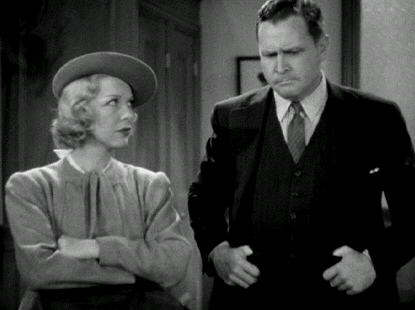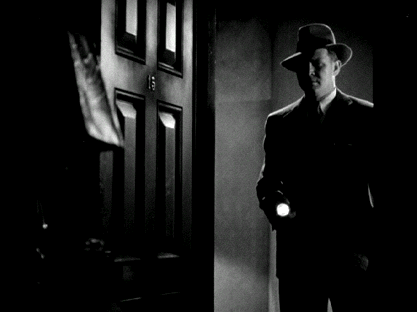Director: Frank McDonald
Writers: Kenneth Gamut, Don Ryan, adapting Frederick Nebel’s story “No Hard Feelings”
Producers: Jack L. Warner, Hal B. Wallis
Cast: Glenda Farrell, Barton MacLane, Winifred Shaw, Addison Richards, Charlotte Wynters (as Charlotte Winters), Robert Paige (as David Carlyle), Craig Reynolds, Max Wagner, Jane Wyman, Tom Kennedy, Joseph Crehan, George Lloyd, Joe Cunningham (uncredited), George Guhl (uncredited)
When racetrack, fight arena, and nightclub owner Fitz Mularkey (Addison Richards) decides to “go legitimate” by getting married and settling down, he agrees to sell his businesses to his reputable friend “Tiny” Torgenson (Joseph Crehan) for much less than some shady operators were offering. Torgenson is soon gunned down. Police Lieutenant Detective Steve McBride (Barton MacLane) is trying to solve the case while warning Mularkey not to take the law into his own hands for vengeance. McBride’s girlfriend, ace newspaper reporter Torchy Blane (Glenda Farrell), assists and exasperates the hard-boiled cop in her zeal to solve the mystery and get the scoop for her paper.
The Flashback Fanatic movie review
Nowadays journalism often seems to be either an anachronism or an affectation. While journalistic standards have always had lapses, those lapses used to be a source of shame when exposed. Much of today’s so-called news is shamelessly crafted just to be clickbait and biased barbs spewed by celebrity talking heads pandering to their chosen ideological market.
The traditional competitive standard of the news media getting the real story quickly and accurately was an inspiring ideal. In the good old days of fewer media outlets in the 1930s, newspapers were probably the most respected conduits of information for public awareness. Newspaper reporters were often regarded with a bit of reverence and romanticized. That’s because the public had not lost the faith in the notion that a free press was vital to truly informing the public so that elected officials could be held accountable. Reporters were the workaday heroes doing their part to maintain a democracy.
To the moviegoers in the depths of the Great Depression, newspaper reporter characters ferreting out the truth were very appealing. There was certainly no more appealing representative of the press than Theresa “Torchy” Blane. Actress Glenda Farrell set the standard for brassy, beautiful reporters back in 1933’s Mystery of the Wax Museum. I was smitten with her in that film and was delighted to find out that she brought her spunk and humor to another female reporter character in the Torchy Blane film series.
Smart Blonde is the first of nine Torchy Blane films made in just two years. Seven of those films star the two-and-only Glenda Farrell and Barton MacLane. Most of these hour-long B films are mysteries that are the duty of Police Detective Steve McBride to investigate and are only solved with the additional wits and daring of his girlfriend, reporter Torchy Blane.
Beautiful blonde Glenda Farrell had been acting on the stage since childhood. She became a very busy film actress at Warner Bros. Pictures throughout the 1930s. Farrell appeared in gangster pictures, dramas, mysteries, and comedies. Her fame probably peaked when she starred as the sassy, daring, and fast-talking heroine of the Torchy Blane films. Farrell’s performance is great fun and the main reason these films became so popular.
Barton MacLane is the perfect surly and burly foil to sassy and sexy Glenda Farrell. MacLane was also under contract to Warner Bros. in the ’30s. He usually played supporting character roles and villains during his film career. It must have been a nice change of pace for MacLane to play the heroic co-starring lead in the Torchy Blane series. By 1939 MacLane would marry Charlotte Wynters who plays Marcia Friel, the fiancée of Addison Richard’s Fitz Mularkey, in Smart Blonde.
Farrell and MacLane play well off of each other. They both portray down-to-earth urbanites dedicated to their professions that benefit the public. The banter and bickering between these two characters are the main charms of these flicks. Torchy loves to tease her hard-boiled cop boyfriend and resents often being told to mind her own business. Of course her newshound instincts can’t be tamed, and she continues to compete with or assist Detective McBride until the culprit is exposed.
As these films are brisk crime dramas full of humor, running gags are established in this very first series entry. Torchy seems to have an insatiable appetite for more than news and is always nagging McBride to take her to dinner (usually a steak). These meals are often postponed due to the demands of McBride’s detective duties. The films are also always teasing the prospect of marriage between these two characters that keeps getting delayed due to the demands of the latest case.
The particulars of this case fly by pretty fast and, as in many B films with their mile-a-minute dialogue, you really need to pay attention. While the story is meant to present our crime-solving couple with a mystery to unravel, the real draw here is being amused along the way with their mutual antagonism and affection.
Farrell’s iconic portrayal of pushy female newspaper reporters inspired the creation of the Lois Lane character by writer Jerry Siegel for his DC Comics Superman stories. It is also interesting to note that the first actress to try replacing Farrell for the fifth film in the series was Lola Lane. That similarity of names could just be an amazing coincidence as the Torchy Blane film that Lane starred in was released one month after the Superman and Lois Lane characters debuted in the first issue of Action Comics. However, many years later Jerry Siegel said that he liked the name of actress Lola Lane whom he was aware had also played Torchy and claimed that suggested his naming of the Lois Lane character. Perhaps prior to the publication of that first Superman story, Siegel had noticed Lola Lane in earlier film roles or else he had read some movie news about Lola Lane replacing Farrell for Torchy Blane in Panama (1938)?
In this nine film series, Warner Bros. Pictures tried replacing the leads Farrell and MacLane twice. Each time the moviegoers did not embrace those replacements. The last film in the series, Torchy Blane... Playing with Dynamite (1939), had Torchy played by Jane Wyman. In this first Torchy Blane film, Wyman appeared in the small role of Dixie, the hatcheck girl.
So, if you long for the days when journalism meant showing the cops how to solve murder mysteries (and looking absolutely fabulous while doing it), tag along on the newsbeat with The Morning Herald’s Torchy Blane. She certainly knows how to increase my circulation.
















Glenda is great in whatever film she appears in, especially her 1930s Warners outings with Joan Blondell.
ReplyDeleteI'll bet that is more great stuff to feed my Farrell fever. Farrell and Blondell teamed up in a lot of comedies that must have also been very popular. This Farrell fan really needs to check those out!
ReplyDeleteI can't believe I call myself a fan of old movies and STILL haven't seen any Torchy Blane flicks! High time I did something about that, as these movies sound like loads of fun. Lola Lane played another brassy newspaper reporter in a 68-minute programmer called DEATH FROM A DISTANCE in 1935. It had a sort of science fiction plot line. It's got some good points but isn't that terrific. But Miss Lane may have provided some inspiration for the Torchy Blane character.
ReplyDeleteHey, maybe that 1935 Lola Lane role as a reporter actually inspired Jerry Siegel's decision to call his Daily Planet reporter Lois Lane! It might explain how he used that name before Lola Lane's Torchy flick was released.
ReplyDeleteI hope you get a chance to see the Torchy Blane films. It took me a while to get around to scooping up that Warner Archive Torchy Blane Collection, but I'm glad that I finally did. I am so lazy that I even procrastinate pursuing my pleasures.
Since we're doing confessions, although I love the wisecracking reporters of '30s cinema, I've never heard of the Torchy Blane series! It says something about Glenda that her successors in the role didn't catch on. And Barton MacLane is always a welcome presence. He was one of those character actors who was all tough guy on the outside, but often revealed a soft side.
ReplyDeleteYeah, MacLane's presence was as important as Farrell's in this series. I think you'd get a kick out of their Torchy Blane films. I consider them the Bogart and Bacall of newspaper reporter crime dramas.
ReplyDelete